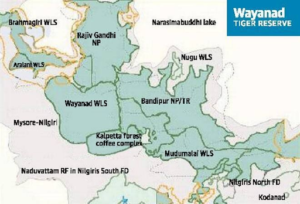In news– With the onset of summer, the seasonal migration of wild animals has begun from the adjacent wildlife sanctuaries in Karnataka and Tamil Nadu to the Wayanad Wildlife Sanctuary (WWS).
About Wayanad Wildlife Sanctuary-
- It is located in Wayanad, Kerala, with an extent of 344.44 km² and four hill ranges namely Sulthan Bathery, Muthanga, Kurichiat and Tholpetty.
- Established in 1973, the sanctuary is now an integral part of the Nilgiri Biosphere Reserve.
- It is bounded by the protected area network of Nagarhole National Park and Bandipur National Park in Karnataka in the northeast, and on the southeast by Mudumalai National Park in Tamil Nadu.
- It is the second largest wildlife sanctuary in Kerala.
- It is bestowed with lush green forests and rich wildlife.
- It is part of the Deccan Plateau and the vegetation is predominantly of the south Indian moist deciduous teak forests and has pastures of the west-coast semi-evergreen trees.
- It comes under Project Elephant.
- Kuruma, Paniya, Kattunaicka, Urali, Kurichiar and Adiyar are some of the tribal communities that inhabit this area.
- Cherupuzha, Bavali puzha, Kabani river, Kannaram puzha, Kurichiat puzha, Chedalathu puzha are some of the rivers that drain in this region.
- Flora: Moist deciduous forest consists of maruti, karimaruthi, rosewood, venteak, vengal, chadachi, mazhukanjiram, bamboos, more, while the semi-evergreen patches comprise veteria indica, lagerstroemia lanceolata, terminalia paniculata.
- Fauna: Elephants, tigers, leopards, jungle cats, civet cats, monkeys, dhole, gaur, deer, sloth bear, monitor lizards and a variety of snakes are seen.
- Birds: Peacocks, babblers, cuckoos, owls, woodpeckers, jungle fowls are a few of the various types of birds seen here.

















